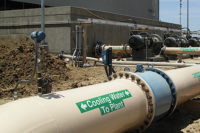Here is where safety signs, labels, tags and other markings play a pivotal role — as the last defensive measure an employer can take to protect employees. The challenge is knowing when and where markings are necessary. OSHA sets marking requirements throughout 29 CFR 1910 and 1926, and the agency can and will cite employers for marking violations (see Table 1).
These regulations spell out what markings are required, often providing the exact text, colors and symbols. However, general marking regulations are found at:
- 29 CFR 1910.144, Safety Color Code for Marking Physical Hazards;
- 29 CFR 1910.145, Specifications for Accident Prevention Signs and Tags; and
- 29 CFR 1926.200 to .203, Signs, Signals, and Barricades.

“Catch allâ€
OSHA also has a “catch all†requirement for posting signs near a wide variety of hazards not specifically mentioned in the regulations. When failing to mark hazards may cause injury or property damage, §1910.145 calls for the use of signs or symbols. Employers will quickly discover that it is up to them to decide what marking is necessary for many hazards.
Several agencies other than OSHA also require markings, including the Environmental Protection Agency, the Department of Transportation, and others. Likewise, many standards organizations call for markings, including the American National Standards Institute (ANSI), Compressed Gas Association (CGA), National Fire Protection Association (NFPA), and others. Be aware that OSHA and other agencies have adopted by reference some of the consensus standards developed by these organizations. For example, §1910.145 adopts ANSI Z53.1-1967, Safety Color Code. These adopted standards have the force of law.

Sending a message
Once you decide that marking is necessary, you must determine what to communicate and how and where the message should be communicated. Generally, markings convey one or more of four types of messages:
- Instructions — include the actions employees must take for a given situation;
- Prohibitions — indicate the actions employees must not take for whatever reason;
- Hazard alerts — convey the hazard and often include danger, warning and caution signal words and messages (see Table 2);
- Information — cover company policies or identify locations; often the signal word “notice†will be used.
Whatever the message, a marking should be direct, accurate and easy to understand. Though not required by OSHA, you may find these standards helpful: ANSI Z535.2-2002, Environmental and Facility Safety Signs; and ANSI Z535.5-2002, Safety Tags and Barricade Tapes (for Temporary Hazards).
OSHA has begun to realize that language barriers, illiteracy and poor reading skills may account for many injuries and illnesses. Marking symbols, such as the skull and crossbones symbol for poison, may solve some of the problem. OSHA-required symbols include, but are not limited to:
- Slow-moving vehicle emblem (§1910.145);
- Biological hazard symbol (§1910.145 and §1910.1030);
- Radio frequency radiation hazard warning symbol (§1910.97);
- Radiation symbol (§1910.1096); and
- Nationally recognized testing laboratory symbols (Part 1910 Subpart S and 1926 Subpart K).
Good symbol design
According to ANSI Z535.3-2002, Criteria for Safety Symbols, many factors such as symmetry, legibility and simplicity determine good symbol design. However, while symbols allow for quicker communication, they cannot replace the textual message.OSHA does not provide much in the way of marking format. However, the most effective markings have consistent formats. Important messages can be lost if multiple formats are used. Refer to ANSI Z535.2 and .5 for suggested layout, font, durability and multilingual formats.
Some say the color of a marking is as important as the message, but only if workers have the ability to distinguish the meanings of the different colors. Also, if the employer applies color inconsistently, the worker may be misled or confused. No matter what the ability of the worker, OSHA calls for specific color schemes for various signs and tags, including, but not limited to:
- Danger sign — red, black and white;
- Caution sign — yellow background, black panel with yellow letters;
- Safety instruction sign — white background, green panel with white letters;
- Biohazard sign — orange-red panel with contrasting symbol and letters;
- Radiation symbol — yellow background, magenta or purple symbol;
- Exit sign — red letters;
- Danger tag for construction — white tag, white letters on red oval with black square;
- Caution tag for construction — Yellow tag, yellow letters on black background.
More safety colors are recommended in ANSI Z535.1-2002, American National Standard for Safety Color Code.
Where’s the sign?
When selecting a marking location, consider the work area. Choose a sign that will reasonably endure area conditions. You may need to protect the sign from damage or add lighting.Markings should be placed so that they alert the worker in time to respond to the message or avoid the hazard. Markings should not be blocked by doors or equipment. Soiled, defaced or missing markings must be replaced.
Finally, markings should be removed when the hazard is eliminated.
